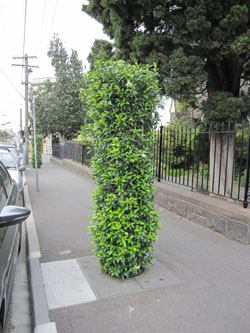resource library
Array
Base of climber pit

Climbing plants thriving in pit

Integration into the streetscape
Glenferrie Road Climber Pits
City of Boroondara
Glenferrie Road, Hawrthorn, VIC | Map:
Published: 24 May 2012
Project Overview
The City of Boroondara has undertaken an innovative project to treat stormwater and improve the streetscape amenity along Glenferrie Road in Hawthorn: Six climber frames located over bio-retention pits (‘climber pits’) were custom-designed and installed on the footpath. The concept was developed by Boroondara's landscape architects in response to the space constraints on the footpaths of Glenferrie Road, which did not allow the use of traditional street trees or WSUD street tree pits.
Early on in the concept phase, Boroondara’s Landscape Architects took a holistic cross-council approach to the design by convening a series of internal workshops which included representatives from the Engineering and Traffic, Projects and Strategy, and Parks and Gardens departments. The workshops ensured early endorsement by all departments which in turn facilitated a smooth design and implementation process.
This project has been considered a great success and more climber frames and bio-retention pits are expected to be installed in other streetscapes across Boroondara.
Drivers and Objectives
This project was driven by the desire to ‘green’ Glenferrie Road, which is a high profile shopping strip with limited room for traditional style street trees and planting.
Another key objective was to capitalise on the opportunity for the system to treat urban stormwater.
Organisations
City of Boroondara (Responsible Council)
Melbourne Water - Living Rivers (Funding Partner)
Aurecon (Design Consultants)
Project Outcomes
Creation of an attractive green streetscape – The benefits of using climbing plants as opposed to trees are that the root system takes up less room, and that they do not have the spreading canopy of a traditional street tree. This allows climber frames to be located in more constrained streetscapes where existing underground services and overhead roof canopies can often limit street greening opportunities.
Stormwater treatment – In addition to greening the streetscape, the climber pits treat the road runoff before it gets discharged into the conventional drainage system, thereby contributing to the protection of receiving waters.
Community education and engagement – the surrounding residents were informed about the project and the timing of implementation. Council representatives also met individually with businesses directly adjacent to each of the sites to establish support prior to works being undertaken. These actions ensured strong up-front community support for the project.
Facilitated maintenance procedures - A key design detail to assist with maintenance of the pits was the inclusion of a permeable mesh-like plastic mat on top of the media. When the pit is being accessed for maintenance, the crew can quickly shovel out any collected rubbish and leaf litter without removing filter media or damaging plant roots.
Lessons Learnt
Council recognised that a key element to the success and buy-in of the project was the early engagement of internal stakeholders. This gave other council departments the opportunity to input into the design process.
Another lesson was the importance of public education for community acceptance of this type of asset. Following installation of the climber frames, Council received significant queries from the community. Indeed, Glenferrie Road is a shopping strip that attracts a broad range of stakeholders. As a result, Council responded by temporarily installing posters on the frames to communicate their intent and purpose. Whilst permanent signs cannot be installed due to space constraints, Council promotes this project via other means such as their website.
Council highlights that it is important for regular maintenance to be undertaken by someone with experience in WSUD infrastructure. Engaging a contractor with this experience allowed the maintenance regime to be reviewed in 2012 and the frequency of litter and sediment removal within the pits to be reduced to occur monthly. This is in line with similar systems within Melbourne and is being monitored to ensure adequate functioning of the pits.
Project Cost
$88,500 for implementation of six climber frames (excludes one-off research, prototyping and design fees), of which $65,000 was funded by Melbourne Water – Living Rivers.
Timeframe
2007/2008 – Design
2008/2009 – Implementation
Contact
T 03 9278 4011
E environment.mailbox@boroondara.vic.gov.au
